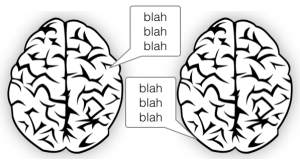
When I first heard the term ‘brain-to-brain interfaces’, my knee-jerk response was – don’t we already have those? Didn’t we used to call them people? But sarcasm aside, it was clear that a new variety of BCI technology had arrived, complete with its own corporate acronym ‘B2B.’
For those new to the topic, brain-to-brain interfaces represent an amalgamation of two existing technologies. Input is represented by volitional changes in the EEG activity of the ‘sender’ as would be the case for any type of ‘active’ BCI. This signal is converted into an input signal for a robotised version of transcrannial magnetic stimulation (TMS) placed at a strategic location on the head of the ‘receiver.’
TMS works by discharging an electrical current in brief pulses via a stimulating coil. These pulses create a magnetic field that induces an electrical current in the surface of the cortex that is sufficiently strong to induce neuronal depolarisation. Because activity in the brain beneath the coil is directly modulated by this current, TMS is capable of inducing specific types of sensory phenomena or behaviour. You can find an introduction to TMS here (it’s an old pdf but freely available).
A couple of papers were published in PLOS One at the end of last year describing two distinct types of brain-to-brain interface between humans.